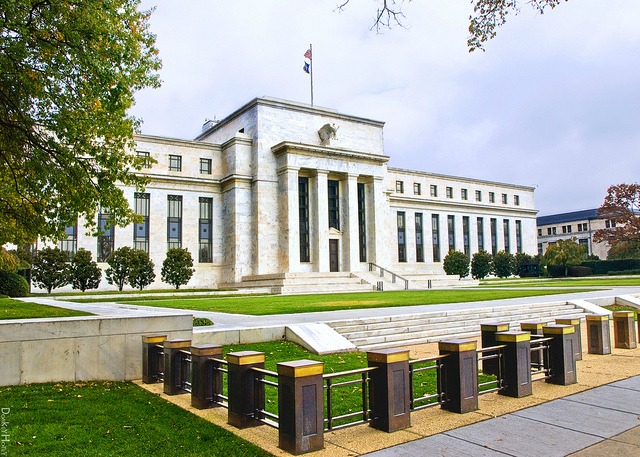Markets have been too sanguine about the chances of further rate hikes this year. For the past three months, the futures market has been pricing in only a one-in-five chance of a second rate hike in June. In response, the Federal Reserve appears to have stepped up its rhetoric to change those expectations. The minutes of the April meeting made it very clear that most Federal Open Market Committee (FOMC) members believed it appropriate to raise rates again in June.
What could change the call slightly is the timing of the “Brexit” referendum in the UK just a week after the 15 June FOMC meeting. While the June rate hike probabilities have remained steady, the likelihood of a July move has shot up well above 50% at the end of May – suggesting markets are catching up with the Fed.
This doesn’t mean we are now likely to see a typical market reaction to a Fed rate hike cycle. The use of forward interest rate guidance – in the form of the “dot plot” of FOMC members’ policy rate forecasts – has given the Fed a second set of interest rates to manipulate, a policy option that didn’t exist in the past. When the committee raised actual policy rates in December, it also cut future interest rates by lowering the number of expected rate increases by 50 basis points. The market reacted in kind; the dollar fell and stocks rose.
We expect the Fed will raise actual policy rates in June or July – depending on Brexit risk. But we also expect the Fed to cut interest rates again in the second half of the year. Right now, the dot plot still signals four rate hikes in 2017 and five in 2018. So there is plenty of room to cut future interest rates to offset macro volatility or, potentially, excessive tightening of financial conditions.
Market moves have been mostly positive
US equities continued to push higher in May despite growing conviction of a summer Fed rate hike and lingering Brexit risk. The US economic news flow may still not be convincingly bullish. Yet the picture that is emerging two months into the second quarter supports our thesis of a growth reacceleration after an extended six-month period with GDP growth trending well below the previous 2.1% recovery average. The S&P 500 index gained nearly 2%, driven by energy, materials, and financials. Bond returns were essentially flat. The Barclays Aggregate index was unchanged for the month, though performance year-to-date is still ahead of the S&P 500.
Benchmark 10-year Treasury yields were little changed. Yet shorter maturity yields increased notably, reflecting the possibility of another Fed rate hike. High yield bonds posted small gains, enough to push returns to 8% for the year. The dollar enjoyed one of the strongest month in the past four years. The Fed’s trade-weighted dollar index was up 3%, and the DXY index, which includes only the six most traded currencies, was up 2.6%. West Texas Intermediate oil prices continued their upward move, albeit at a much slower speed compared with that in April and March, briefly touching the $50-per-barrel mark intraday before retreating.
The economy looks good, right?
US equity markets seem cautiously optimistic about the outlook, and the economic news flow is starting to tilt in that direction. However, we are not without our fair share of question marks. Seasonality has played a major role in recent years, leading to slower growth at the start of the last three years, averaging just 0.2%. In the last two years, growth reaccelerated back to 3% in the remaining three quarters. That is, essentially, what we are looking for again this year. Retail sales, industrial production, and virtually all housing-related numbers rebounded in April, starting the quarter on the expected bullish note. What’s more important is that strong April household spending suggests consumption, still 69% of total GDP, is on track to grow between 3% and 3.5% this spring. This sets the stage for the now-familiar spring and summer growth reacceleration.
One question mark arises from business and consumer surveys. If economic prospects are looking good, then why are they more consistent with sluggish economic growth? The average of the two main US consumer confidence indexes reversed the surprise April decline, but this doesn’t signal a material improvement over the previous six months. The average of the two manufacturing purchasing managers indexes improved marginally, but at 51 is barely trading above the expansion/ contraction threshold for the sector. Weak business activity was partly the result of a profit recession last year. Reported profits fell more than 3%, the first decline in seven years. Profitability improved marginally in the first quarter, with domestic non-financial corporate profits up about 4%. Yet financials and profits from overseas operations continued to contract, highlighting the difficulties of a low-interest-rate environment and weak trade growth.
The economy is on track for the second-quarter US growth reacceleration we have been forecasting for a while. However, there is a question mark here, too: Can that stronger pace can be sustained in the second half of this year? US business activity needs to rebound more convincingly to make the stronger growth trend stick. Yes, housing activity is picking up again, but the sector is too small to make a significant difference. Purchasing managers indexes show little evidence of a global growth bounce, so trade will remain a headwind. Rising inflation could be the next problem if wages and income don’t keep pace. We already saw a noticeable slowdown in real disposable income growth in April. The Fed should be careful what it wishes for.
The outlook is warming up for summer
Now that we are through the bad news of the winter quarter, US GDP growth is set to pick up again. Our forecast of a 3% average between April and December is well above the 2.3% consensus among the economists polled regularly by Bloomberg. US inflation has moved up and is likely to trend between 1% and 1.5% for much of the rest of the year. Traditionally, rising policy rates would also push up bond yields. Yet we see a dichotomy between rising actual rates, but likely falling future policy rates, and the pull from extremely low government bond yields in the eurozone and Japan. This means 10-year Treasury yields are likely to remain range-bound between 1.75% and 2.25% for the rest of the year.
Markus Schomer is Chief Economist at Pinebridge Investments.


